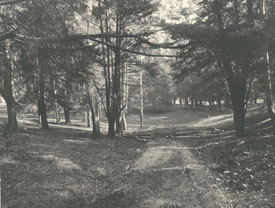The Greek Theatre at 100
The campus's landmark venue has been the site of a long run of cultural, social, and political events![]()
 Flash
slide show: The Greek Theatre at
100 Flash
slide show: The Greek Theatre at
100 |
17 September 2003
| |
 The idea of constructing a classic Greek theatre in Berkeley is credited to UC President Benjamin Ide Wheeler, who was intimately familiar both with Greece and its classical ruins. Funds for the theatre were provided by William Randolph Hearst, at the urging of his mother, UC benefactor Phoebe Apperson Hearst. The principal design was executed by University Architect John Galen Howard, who took as his model ancient theatres such as those at Epidaurus and Pompeii, amalgamating both Greek and Roman elements in his design. Construction of the theatre — which was sited in a shallow hillside bowl (above) known familiarly as Ben Weed's Amphitheatre — was supervised by Weed's 1894 classmate, Julia Morgan. Photo courtesy of the Bancroft Library |
It has survived the raucous cheers of rooters, the chants of demonstrators, and the soaring notes of operatic divas. Presidents, diplomats, poets, and a "living god" have held forth from its broad stage. Bob Dylan, The Talking Heads, The Grateful Dead, Phish, Elvis Costello, Genesis, R.E.M., Pearl Jam, Joan Baez, The Gipsy Kings, Milton Nasciamento, James Taylor, and the Dave Matthews Band have played "The Greek."
The sounds of solemn university ceremonies, enthusiastic spirit rallies, stirring speeches, and a counterculture "Tribal Stomp" of the 1960s, have resounded from its rugged concrete walls, and hundreds of thousands of spectators have looked down over the decades from its steeply tiered seats.
For exactly one century the Hearst Greek Theatre has stood imperially (and somewhat precariously) on the eastern edge of the Berkeley campus, adjacent to the Hayward Fault, serving as setting for many of the university's memorable events and an ever-changing parade of cultural and entertainment traditions.
Upon its completion in 1903, the Greek was pressed into use for campus ceremonials — Charter Day, commencements, University Meetings, and a variety of special events — a tradition that continues to this day. But as the first great campus venue for performance art, the Greek also provided a significant stimulus to cultural activity at Berkeley. Early appearances by the likes of Sarah Bernhardt and Luisa Tetrazzini helped build the still-young university's prestige — in keeping with the turn-of-the-century ambition, on the part of both the institution and the city of Berkeley itself, to become an unrivaled center of culture and enlightened learning ... a veritable "Athens of the West."
Though the Greek has, over the first century of its life, become accustomed to cheering crowds and high-profile events, it also provides an unmatched setting for contemplation, should one be lucky enough to find oneself there when the ranks of seats are empty, the stage is silent, and beneath a clear blue sky the sea breezes rustle though the surrounding stands of eucalyptus. It is then that the words of the poet (and Berkeley professor) Edward Roland Sill, inscribed on his memorial chair in the theatre, can be properly appreciated:
'Tis not in seeking;.
'Tis not in endless striving
Thy quest is found.
Be still and listen:
Be still and drink the quiet
Of all around.
— Steven Finacom

